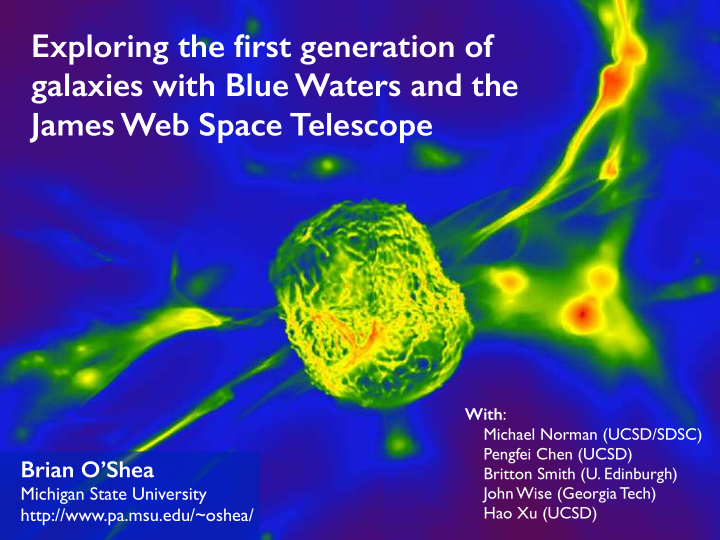



Exploring the first generation of galaxies with Blue Waters and the James Web Space Telescope With : ! Michael Norman (UCSD/SDSC) ! Pengfei Chen (UCSD) ! Brian O’Shea Britton Smith (U. Edinburgh) ! Michigan State University ! John Wise (Georgia Tech) ! Hao Xu (UCSD) http://www.pa.msu.edu/~oshea/
Special thanks to: Manisha Gajbe (Blue Waters technical POC) ! Bill Kramer and all of the Blue Waters team ! National Science Foundation The Enzo and yt communities: ! enzo-project.org ! yt-project.org !
Image c/o NASA
Our goal: Understanding the first generations of galaxy formation
Why is studying galaxy formation challenging?
Our simulation tool: Bryan et al. 2014, ApJS, 211, 19 ! http://enzo-project.org Our analysis/viz tool: Turk et al. 2011, ApJS, 192, 9 ! http://yt-project.org !
Lots of results! • Xu et al., “Heating the Intergalactic Medium by X-Rays from Population III Binaries in High-redshift Galaxies,” 2014, ApJ, 791, 110 ! • Chen et al., “Scaling Relations for Galaxies Prior to Reionization,” 2014, ApJ, 795, 144 ! • Ahn et al., “Spatially Extended 21 cm Signal from Strongly Clustered UV and X-Ray Sources in the Early Universe”, 2015, ApJ, 802, 8 ! • O’Shea et al., “The ultraviolet luminosity function of the earliest galaxies,” 2015, ApJ submitted (arXiv:1503.01110) ! • Smith et al., “The First Population II Stars Formed in Externally Enriched Mini-halos,” 2015, ApJ submitted (arXiv:1504.07639) ! • Xu et al., “Ionising Photons From Faint Galaxies During the Epoch of Reionization,” 2015, ApJ, in prep (submitting ~June 1st) ! • Shi et al., “The Dynamics of Seed Black Holes in the First Galaxies,” 2015, ApJ, in prep. (submitting ~July) And much more to come!
Focus areas The transition to metal-enriched star formation: Britton Smith*, John Wise*, BWO ! ! Evolution of early galaxy populations: Hao Xu*, Pengfei Chen, Mike Norman, Kyungjin Ahn, BWO * Ran the simulations
The transition to metal-enriched star formation • Small volume : 0.5 Mpc/h box ! • Extremely high resolution : 15 levels of AMR prior to explosion (0.029 pc comoving max); 30 after (~1 au comoving); ~0.19 M ☉ gas, 0.92 M ☉ dm mass resolution ! • Sophisticated physics: ! • Primordial gas + metal + dust chemistry & cooling ! • Radiation transport for Pop III stars; core-collapse supernovae w/11.2 M ☉ of metals Smith et al. 2015 (submitted; arXiv:1504.07639)
Smith et al. 2015 (submitted; arXiv:1504.07639)
Metal mixing Physical timescales Smith et al. 2015 (submitted; arXiv:1504.07639)
Evolution of early galaxy populations • Large volume: 40 Mpc box, refine on three separate ~300 Mpc 3 regions (overdense, average, low density) ! • High resolution: Simulation at 12 levels of AMR (19 comoving pc), primordial + metal-enriched chemistry, Pop III and metal-enriched SF ! • Lots of galaxies: 13,000 Pop III stars formed, ~3,000 halos > 10 7 M � (with star formation) by end of simulations Xu et al. 2014, 15; Ahn et al. 2015; ! Chen et al. 2014; O’Shea et al. 2015
z = 15 Normal proper Rare peak Void 16 proper
What’s in the “rare peak” region? z = 15 proper kpc Projected Density Projected Temperature (scale: 3 x 10 -28 – 3 x 10 -24 g/cm 3 ) (scale: 10 3 – 3 x 10 4 K)
1.0 80 f halo with Pop III Pop III per halo z = 18 0.8 60 0.6 N Pop III f halo 40 0.4 z = 15 20 0.2 XRBs 0.0 0 f halo with Pop III Pop III per halo 0.8 z = 15 60 0.6 N Pop III f halo 40 0.4 20 Xu et al. 2014, ! 0.2 ApJ, 791, 110 0.0 0 10 6 10 7 10 8 10 9 Halo Mass [M O • ]
Luminosity function of early galaxies O’Shea et al. 2015, ApJ, submitted (arXiv:1503.01110)
Luminosity function of early galaxies O’Shea et al. 2015, ApJ, submitted (arXiv:1503.01110)
Luminosity function of early galaxies O’Shea et al. 2015, ApJ, submitted (arXiv:1503.01110)
Luminosity function of early galaxies Electron fraction ! Density (ionizing radiation)
Simulation data as a community resource • Simulation tool (Enzo) and analysis/viz tool (yt) are open-source community codes. ! • We are making all of our datasets (and resulting data products) publicly available via the National Data Service and NDS Labs. ! • These simulations were very expensive and will be a community resource for years to come! Cutting-edge simulations have a long tail of utility!
Takeaways • The transition between primordial and metal- enriched star formation is locally complex, and the outcome is strongly affected by the presence of dust. • Multiple Pop III stellar remnants wind up in each high-sigma halo: X-ray binaries? SMBH progenitors? • Star formation is inefficient (and sometimes suppressed entirely) in small, high-z galaxies - turnover in UV luminosity function predicted. • This would have been undoable without a machine like Blue Waters: memory, interconnect, fast IO.
Recommend
More recommend